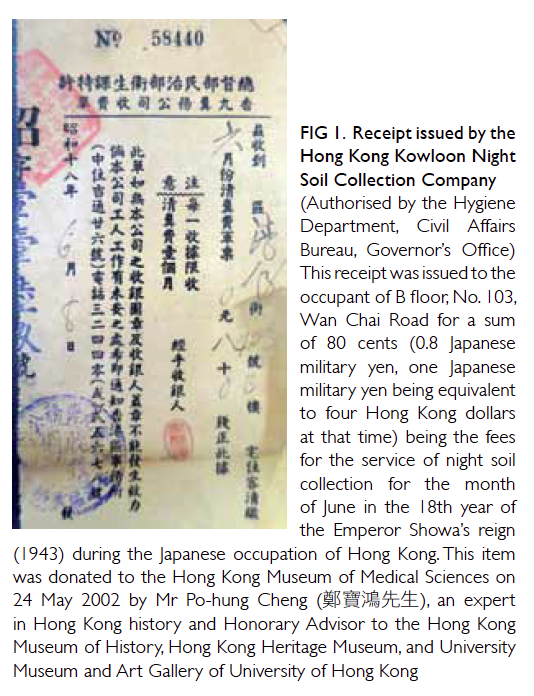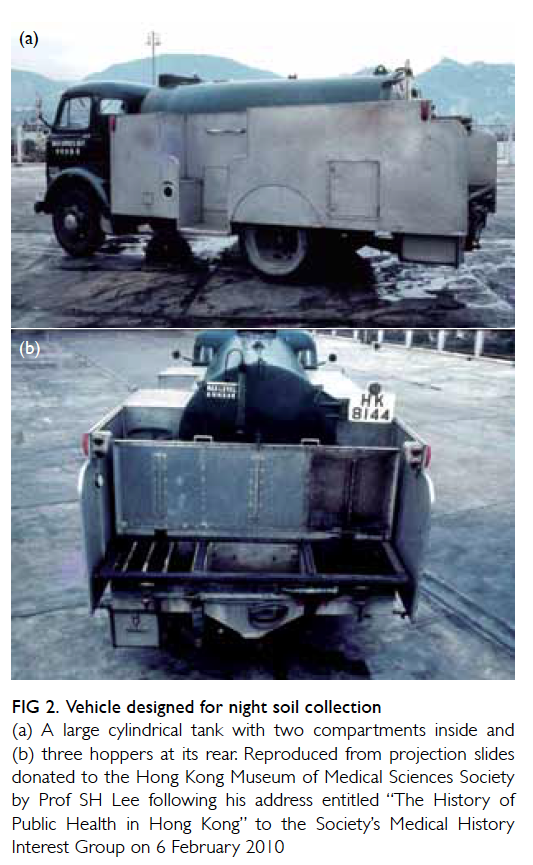© Hong Kong Academy of Medicine. CC BY-NC-ND 4.0
REMINISCENCE: ARTEFACTS FROM THE HONG KONG MUSEUM OF MEDICAL SCIENCES
The business of night soil collection
Moira Chan-Yeung, FHKCP, FRCPC (Internal Medicine)
Honorary Clinical Professor, The University of Hong Kong; Emeritus Professor of Medicine, University of British Columbia;
Member, Education and Research Committee, Hong Kong Museum of Medical Sciences Society
Until the end of the 19th century, Hong Kong was
known for its insanitary conditions, especially in
the Tai Ping Shan area, the Chinatown of Hong
Kong. Only the houses of wealthy Europeans had
water closets. Those of wealthy Chinese and some
Europeans had dry latrines but these were only for
men. Women and children of all classes used pots,
generally kept under the bed. For private houses,
night soil (human waste) was collected by female
coolies at night into buckets and the contents emptied
into junks that came alongside the waterfront at
specified points in the early hours of the morning.
The occupants of private houses paid a small sum for
the service, depending on the frequency of removal.
For daily removal (usually only for Europeans and
wealthy Chinese), the charge was HK$0.5 to $1 per
month; for removal every second day, the cost for
each family was HK$0.3 to 0.4 per month.
Working class men used public dry latrines.
Built and run by private persons as a business
venture, these latrines were invariably crowded and
unhygienic. The owner derived his profit from the
sale of the manure collected and from fees paid by
the users while the government obtained a share
of the profit by levying a tax of HK$0.60 per seat
per annum. The night soil from these latrines was
removed daily, in covered tubs, by the government
scavenging contractor, who provided collecting
junks for all night soil from public latrines,
government buildings, jails, and prisons as well as
from private houses. The boats carried the night soil
to Guangzhou or somewhere in China where it was
sold as fertiliser. The government contractor also
supplied the crew for street sweeping. This rubbish
was carried by boats to Lap Sap Wan (Gin Drinkers
Bay), and simply thrown onto the beach.1
The contractor received nothing from the
government. The people in the City of Victoria paid
nothing out of public funds for scavenging—the
value of the night soil collected was considerably
higher than the cost of performing this duty. Human
excreta were highly prized by the Chinese farmers as
manure. They were composted by mixing with ashes
or refuse, but often diluted with water according to
the nature of the crop to which they were applied.
The chief demand was for mulberry trees in the silk-producing
districts north of Guangzhou.1
This system of night soil collection persisted
during the Japanese occupation. The Second World
War disrupted transportation between Hong Kong
and the mainland and also farming in southern
China. Initially the collected night soil was dumped
into the harbour but later the Japanese built a
system of tanks at Castle Peak and smaller ones at
Tsuen Wan and Tai Po for the collected night soil to
‘mature’ (a process to reduce the risk of infection)
before selling on to farmers in the New Territories.2
The receipt issued by the night soil collection
company to an occupant of a flat in Wan Chai Road
shows that night soil disposal for private houses was
more expensive than before the War (Fig 1).

Figure 1. Receipt issued by the Hong Kong Kowloon Night Soil Collection Company
(Authorised by the Hygiene Department, Civil Affairs Bureau, Governor’s Office) This receipt was issued to the occupant of B floor, No. 103, Wan Chai Road for a sum of 80 cents (0.8 Japanese military yen, one Japanese military yen being equivalent to four Hong Kong dollars at that time) being the fees for the service of night soil collection for the month of June in the 18th year of the Emperor Showa’s reign (1943) during the Japanese occupation of Hong Kong. This item was donated to the Hong Kong Museum of Medical Sciences on 24 May 2002 by Mr Po-hung Cheng (鄭寶鴻先生), an expert in Hong Kong history and Honorary Advisor to the Hong Kong Museum of History, Hong Kong Heritage Museum, and University Museum and Art Gallery of University of Hong Kong
Water was a rare commodity during the latter
part of the 19th century and early 20th century, and
had to be carried from public hydrants to the house.
The manual disposal of human excreta and the lack
of water and proper sewage disposal in Chinese
tenement houses led to the high prevalence of food- and
water-borne diseases such as cholera, dysentery,
and infective diarrhoeas and the ease with which
they could become epidemic.
Even before the Second World War, newly built
houses were required to have water closets. With
the replacement of old houses by new ones after the
War, fewer houses required night soil collection.
The process of modernisation was nonetheless slow;
in 1996 there remained some areas that required a
night soil collection service, although this was free
of charge.3
Interestingly this method of night soil removal
was useful during the 1961 to 1963 cholera outbreaks
as it enabled tracing of the source of infection and
contacts.4 By this time, night soil disposal was
‘modernised’ and more mechanised. The collected
night soil was emptied into special vehicles (清糞車)
designed for this purpose and in a hygienic manner
at fixed points along a number of set routes every
night. These vehicles discharged the night soil into
barges that either took the contents to storage tanks
for maturation, or dumped it if not required. Each
vehicle had a huge tank with two compartments, one
for night soil and one for water. At the back of the
vehicle were three hoppers: the first for the receipt
of night soil, the second for water and the third
for disinfecting fluid. The pails of night soil were
emptied into the first hopper, rinsed in the second,
and disinfected in the third (Fig 2).4

Figure 2. Vehicle designed for night soil collection
(a) A large cylindrical tank with two compartments inside and (b) three hoppers at its rear. Reproduced from projection slides donated to the Hong Kong Museum of Medical Sciences Society by Prof SH Lee following his address entitled “The History of Public Health in Hong Kong’ to the Society’s Medical History Interest Group on 6 February 2010
In January 1962, the Department of Health
began taking samples from the night soil vehicles
while they were discharging into the barges. Three
to four random samples were taken each week
from each vehicle. After a positive sample was first
reported, the vehicle was investigated with the object
of tracing the infection back to its source. Thus when
a sample from a vehicle was positive, each of the
loads collected by the vehicle was sampled; when
one load was positive, each pail forming that load
was sampled. When a pail was found to be positive,
the Health Officer took rectal swabs from all the
residents in the house or flat in which the latrine
was situated. The results of this study enabled the
Medical and Health Department to conclude that
the 1962 epidemic originated from several sources
and that there was a large number of symptomless
carriers among the population. Suitable preventive
measures were then instituted.5 Using night soil
surveillance, the Department was able to forecast
when and in what area a future outbreak of cholera
was likely to occur, to determine when the outbreak
was over and the colony was free from infection,
to trace the infection to its source, and to study its
spread within Hong Kong.6 Ironically, if the entire
population had had access to a water closet, this
valuable information would not have been available
and it would have been much more difficult to make
any accurate forecast of such an epidemic.
References
1. Mr. Chadwick’s reports on the sanitary condition of Hong Kong with appendices and plans. Eastern No 38. November, 1882. Hong Kong: Colonial Office; 1882: 18-21.
2. Selwyn-Clarke PS. Report on Medical and Health Conditions in Hong Kong. For the period 1 January 1941 to 31 August 1945. London: His Majesty’s Stationery Office; 1946.
3. Hong Kong 1997. A Review of 1996. Hong Kong: Hong Kong Government; 172.
4. Vandelinde PA. Observations on the spread of cholera in Hong Kong, 1961-1963. Bull World Health Organ 1965;32:515-30.
5. McCreery WC. The occurrence and treatment of El Tor cholera in Hong Kong, 1961-1963. Hong Kong: Department of Health; 1965.
6. Forbes GI, Lockhart JD, Bowman RK. Cholera and nightsoil infection in Hong Kong, 1966. Bull World Health Organ 1967;36:367-73.

